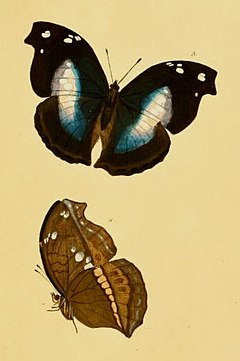Napeocles
Napeocles jucunda, the great blue hookwing, is a South American butterfly of the family Nymphalidae. The species was first described by Jacob Hübner in 1808.
| Napeocles | |
|---|---|
| Mounted specimen | |
| Scientific classification | |
| Kingdom: | |
| Phylum: | |
| Class: | |
| Order: | |
| Family: | |
| Subfamily: | |
| Tribe: | |
| Genus: | Napeocles Bates, 1864 |
| Species: | N. jacunda |
| Binomial name | |
| Napeocles jucunda (Hübner, 1808) | |
| Synonyms | |
| |
Taxonomy
It is the only representative of the monotypic Neotropical lowland genus Napeocles, erected by Henry Walter Bates in 1864. It has been assigned to the recently resurrected tribe Victorinini.[1] The species is very similar to some species in tribe Kallimini.
Subspecies
Subspecies include:[2][3][4]
- Napeocles jucunda jucunda Hübner, 1808
- Napeocles jucunda caesari Neild, 2008 (Venezuela)
- Napeocles jucunda dumnorix Fruhstorfer, 1912
Distribution

This species has been recorded in Peru, Bolivia, Venezuela, Brazil, and French Guiana.[5]
Habitat
These butterflies occur in tropical rainforest across the Amazon basin and from the eastern slopes of the Andes.[5] They can usually be found high in the canopy, but sometimes they are also present on the lower foliage of trees and on humid cacao-groves on fallen fruits.[6][7] The eggs and pupae are very similar to that of Siproeta stelenes, but the final instar larvae is characterized by a dark maroon basal color, with the thorax and abdomen flecked by numerous yellow specks.[5] The immature stages feed on plants in the genus Ruellia.[5]
Description
Napeocles jucunda can reach a wingspan of about 10 cm (3.9 in). These fairly large, wide-winged fine butterflies show a very hard projection on the hindmargins of the forewings, just below the tip, with a deep concavity below. The hindwings are round. The basic color is black or dark brown, with a broad blue to intense white band crossing the middle of the forewings and hindwings. The tip of the forewings shows also a small blue spot. The underside of the wings is colored like a wilted leaf, complete with "middle nerve".[8][9]
Bibliography
- Lamas, G. ed. (2004). Atlas of Neotropical Lepidoptera. Checklist: Part 4A Hesperioidea - Papiionoidea. Gainesville: Scientific Publishers/Association of Tropical Lepidoptera.
- Palo Jr., Haroldo (2017). Borboletas do Brasil [Butterflies of Brazil]. volume 2. Nymphalidae 1st ed. São Carlos, Brazil: Vento Verde. p. 1254. ISBN 978-85-64060-10-4
- D'Abrera, Bernard (1984). Butterflies of South America. Hill House ISBN 0-9593639-2-0
External links
- "Species Napeocles jucunda". Butterflies of America.
- Brower, Andrew V. Z. "Napeocles H. W. Bates 1864". Tree of Life Web Project.
- Carter, D. (1994). Sommerfugler fra hele verden. Teknologisk Forlag. ISBN 82-512-0438-0
- Napeocles jucunda on Flickr
References
- "The Subfamily Nymphalinae". The Nymphalidae Systematics Group. Archived from the original on December 4, 2007.
- "Family Nymphalidae Rafinesque, 1815 – Brushfoots". Butterflies of America. Retrieved June 26, 2020.
- Beccaloni, G.; Scoble, M.; Kitching, I.; Simonsen, T.; Robinson, G.; Pitkin, B.; Hine, A.; Lyal, C., eds. (2003). "Napeocles jucunda ssp. dumnorix". The Global Lepidoptera Names Index. Natural History Museum. Retrieved June 26, 2020.
- Savela, Markku (August 27, 2017). "Napeocles Bates, 1864". Lepidoptera and Some Other Life Forms. Retrieved June 26, 2020.
- Rosser, Neil; Pezo, Ronald Mori (2017). "Color pattern divergence in Napeocles jucunda Hübner, 1808 (Nymphalidae) is accompanied by shifts in host plant and habitat use". Tropical Lepidoptera Research. ISSN 2575-9256.
- "Great Blue Hookwing Napeocles jucunda Hübner, 1808". Butterflies of the Amazon and Andes. Learn About Butterflies. Retrieved June 26, 2020.
- Bates, H. W. (1864). "Contributions to an Insect Fauna of the Amazon Valley Lepidoptera - Nymphalinae". Journal of Entomology. 2 (10): 194 – via Internet Archive.
- Kirby, W. F. (1896). A Hand-Book to the Order Lepidoptera. Lloyds's Natural History. p. 104 – via Internet Archive.
- Kirby, W. F. (1877). "Introductory Papers on Lepidoptera". The Entomologist. 10: 241 – via Internet Archive.
| Wikimedia Commons has media related to Napeocles. |